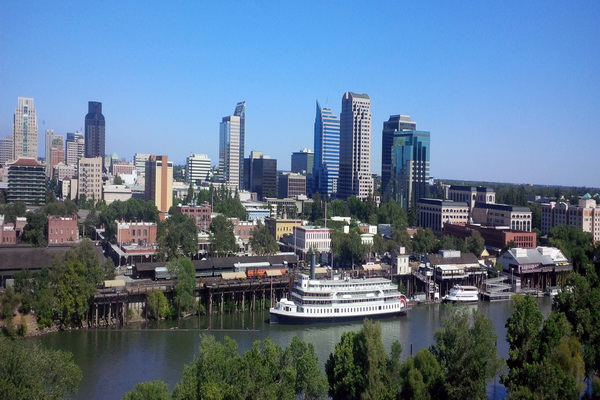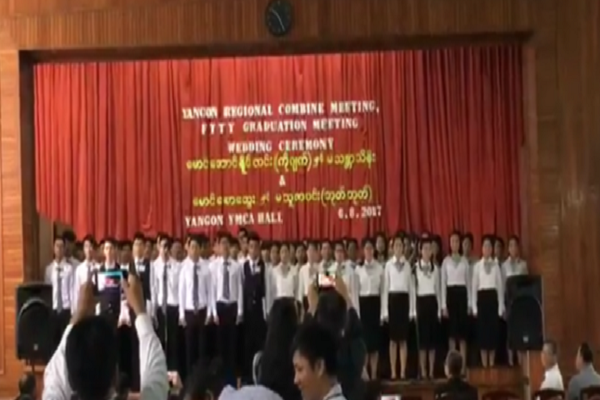Cambridge Church History T
Cambridge
Church History Tour
Introduction
The University of Cambridge was founded in the early 13th century by a group of scholars, including theologians, who had fled from Oxford. This tour is a suggested route of places and their significance.
1. The Round Church
The Round Church building (see photo) dates back to about 1130 AD, and is one of the oldest buildings in Cambridge. It was influenced by the round Church of the Holy Sepulchre in Jerusalem, built by the Roman Emperor Constantine in the 4th century. This Round Church was built following the First Crusade in 1097, by the Norman “fraternity of the Holy Sepulchre”. Most church buildings in Western Europe are cross-shaped, and this is one of only four other round churches in England. The round shape is thought to celebrate the resurrection, as Constantine’s church in Jerusalem was built on the site of Jesus’ tomb and resurrection.
2. Old Faculty of Divinity (Selwyn Divinity School)
The statues on the façade of this building, from south to north, are of eight theologians related to Cambridge: Erasmus, Lancelot Andrewes, J. B. Lightfoot, Cranmer, Fisher, Pearson, Parker, and J. Lightfoot. Above the door to the main entrance are John Fisher (1469) and Thomas Cranmer(1486). Fisher was executed by Henry VIII and Cranmer was executed by Henry’s daughter Mary. Cranmer came to Cambridge at the age of 14. Later, Cranmer helped Henry divorce Catherine of Aragon, whereas Fisher opposed and was executed by Henry. This began the break from Catholicism in England, and the establishing of the Church of England, and was also the beginning of the Reformation in England.
3. All Saints Passage and Statue of Erasmus
Built in the corner of All Saints Passage is a statue of Desiderius Erasmus (1466). He taught Greek at Cambridge from 1511 to 1514. He was unwittingly another major player as he basically put the Bible back into Greek. Erasmus published his Critical Edition in 1516, the first non-Latin Vulgate text of the Bible in a millennium. His translation revealed enormous corruptions in the Vulgate’s integrity. Additionally, the Vulgate had ended up in Latin because it was the papal system’s attempt to take the Bible out of the hands of the common people. Therefore, Erasmus was extremely influential because he put the Bible back into the hands of the common people. In everything the Lord does, His Word goes first.
In 1522, Martin Luther translated the New Testament into German from Erasmus’s Greek/Latin New Testament. In 1525, William Tyndale, who studied both in Oxford and Cambridge (1517-1521) and was a gifted linguist (he became fluent in eight languages: English, French, Greek, Hebrew, German, Italian, Latin, and Spanish), translated the Bible into English. He was convinced that the way to God was through His word and that Scripture should be available even to common people. However, it could not be done in England, so he showed up on Luther’s doorstep, and by the end of the year had translated the New Testament into English. He largely based his translation on Erasmus’s Critical Edition. There was a huge resistance to the translation, and printed copies were burned as soon as they were confiscated. However, copies trickled into England, hidden in bales of cotton and sacks of flour. Tyndale was incarcerated for 500 days before being strangled and burned at the stake in 1536 (see illustration). His last words were, “Lord, open the eyes of the King of England”. Only three years later, Henry VIII authorised the publishing of “The Great Bible”, which was in English, and was largely based on Tyndale’s work.
4. St John’s College & the former Amana Tea Room
If you stand with your back to the main entrance of St John’s, you are on All Saints Passage, and you can see the location where The Little Tea Room (see right) used to be.
William Wilberforce, who was responsible for the abolition of slavery, attended St John’s in 1776. Wilberforce’s involvement in the abolition movement was motivated by his desire to put Christian principles into action and to serve God in public life.
5. Trinity College
Next to St John’s is Trinity (see right), the wealthiest college and third largest landowner in the whole of the UK. Of the Cambridge Seven, C. T. Studd, Stanley Smith and Montagu Beauchamp attended Trinity. Smith and Beauchamp were friends from prep school, and were both on the rowing team, and Beauchamp was childhood friends with the Studd family. Smith received the Lord at the age of 13 during D. L. Moody’s three-year evangelical tour of the British Isles. However, it was seven years later, while studying at Cambridge, that he “decided by God’s grace to live by and for Him,” becoming the first member of the Cambridge Seven. One day in February 1881, Smith, Beauchamp and Kynaston Studd (C. T.’s older brother) were hanging pictures in Studd’s room, and Beauchamp left early. Smith and K. Studd prayed for Beauchamp who was a nominal Christian, although he came from a missionary family. They agreed to pray together for 15 minutes every day for their friend, and in October Beauchamp “yielded all to Christ.” These brothers attended daily prayer meetings hosted by a sister in All Saints Passage.
6. Great St Mary’s
Great St Mary’s historically played a central role in Cambridge University life. Outside the entrance, which is opposite the Senate House, there took place in 1521 a burning of all Martin Luther’s literature that could be found.
7. Gonville & Caius College
In the same area where Luther’s literature was burnt (Great St Mary’s), there is a college called Gonville and Caius. This was the place where D. M. Panton studied. He was very influential in the Lord’s recovery because it was both he and Robert Govett that rendered Watchman Nee help concerning the kingdom truth. The matter of the loss and reward of the kingdom comes from Govett and Panton. Panton succeeded Govett as pastor at Surrey Chapel, in Norwich. Margaret Barber met Panton when she returned from China, and in 1909 he and Surrey Chapel supported her for her return to China, where Miss Barber became a great help in perfecting Watchman Nee.
“D. M. Panton once said that the Christian teachers of his day were giving out tickets for others to enter into the kingdom of the heavens. When they got there, however, said Panton, the gate- keeper would tell them that their tickets were not genuine. According to Panton, too many Christian preachers were cheating their listeners and giving them worthless tickets. Panton was very clear about the matter of the kingdom of the heavens.”
The Basic Revelation in the Holy Scriptures, Witness Lee
8. King’s College
John Frith studied in Cambridge, first at Queens, then graduating from King’s. He met Thomas Bilney, a graduate student of Trinity Hall, and began to join meetings concerning the Reformation. He only lived to the age of thirty, but in that time wrote many books that were deemed to be heretical. He was sentenced to death by fire, but offered a pardon if he answered positively to two questions: Do you believe in purgatory, and do you believe in transubstantiation? His response was that neither purgatory nor transubstantiation could be proven by Holy Scriptures, and thus he was condemned as a heretic and was burned at the stake in 1533.
8.5. Trinity Hall
Thomas Bilney, a graduate of Trinity Hall, was quite influential and was the first Reformer to be burned on English soil. Finding no satisfaction in his studies, he turned his attention to the Erasmus’ Greek edition of the New Testament. He purchased and smuggled a copy into his chambers, and as he opened the precious book, his eyes fell upon the words of 1 Timothy 1:15: “Here is a trustworthy saying that deserves full acceptance: Christ Jesus came into the world to save sinners, of whom I am the worst.” New light flooded Bilney’s fearful soul as the Holy Spirit applied the truth. While meditating on these words he exclaimed triumphantly, “I also am like Paul, and more than Paul, the greatest of sinners, but Christ saves sinners.” Although a shy man, he began to preach in the colleges with boldness, to the astonishment of his friends. He even influenced Hugh Latimer, previously a zealous Catholic “Saul of Tarsus”, who through Bilney’s prayer and personal witness experienced a Damascus-road conversion.
9. White Horse Tavern & “Little Germany”
Luther, Professor of Biblical Exegesis at Wittenberg University in Saxony, was horrified at the sale of ‘indulgences’ and pinned up his ’95 Theses’ in protest in the castle at Wittenberg in 1517. In 1520, copies of his early writings were smuggled into London and Cambridge. News of their arrival reached the ears of Cardinal Wolsey who had them burned outside the door of Great St Mary’s.
However some were saved in time and given to a group of scholars – University and monastic – who met in a back room of a tavern named The White Horse Inn (off King’s Parade, Cambridge). There they examined them and compared them with the recent New Testament translation produced by Erasmus (Professor of Theology at Cambridge). The scholars fell foul of sneering townsfolk who despised them for contemplating the teachings of foreigners. In due course the group came to be known pejoratively as ‘Little Germany’.
The group included Barnes, Bilney, Bradford, Coverdale, Frith, Latimer, Matthew Parker (later Archbishop of Canterbury), Ridley, Rogers, Tyndale and some dozen or more others.
www.opencambridge.cam.ac.uk
10. St Edward’s King and Martyr
At the Midnight Mass on Christmas Eve 1525, one of the group that met at the While Horse Tavern, Robert Barnes, gave what is believed to be the first openly evangelical sermon in any English church, and accused the Catholic Church of heresy at St Edward’s. Over the next decade many of the great reformers preached at St Edward’s, including Latimer, who was a regular preacher until he left Cambridge in 1531. Latimer’s pulpit is still at St Edward’s. These events have led to St Edward’s being referred to as the “Cradle of the Reformation”.
11. Emmanuel College
There is a college colloquially known as “Emma”, Emmanuel College. Of the first 100 graduates to go to the new world (America), 35 were from Emma. One of these was called John Harvard, and he was the first large benefactor to a new school in Newton, Massachusetts. That school is now Harvard University. There is a commemorative plaque outside Harvard making mention to Cam- bridge, and that is why Harvard University is in Cambridge, Massachusetts.
There was another brother from Emma called William Law. He was also very influential and was later known as a mystic. His book, A Serious Call to a Devout and Holy Life, published in 1728, is heralded as a beacon, a lighthouse among Christian publications, and deeply influenced the leading brothers in the great Evangelical revival, including John and Charles Wesley, George Whitefield, and Henry Venn. He was on the inner life line, that is, Christian perfection through the matter of the Spirit. He was pursuing this line contrary to what Catholicism was doing up to that time, and pulled together many of the mystic writings.
“Some time ago I heard that one writer said that there were two William Laws. The first William Law was a man of doctrine, knowledge, theology, letter, and tradition. The second William Law was a person of the Spirit and in the Spirit. The first William Law did not know anything concerning the Spirit, although he had much knowledge of theology and tradition. But one day he had a new beginning, and he became a person of the Spirit. This was the one who improved upon the teachings of certain mystical writers and made those teachings practical. We may say that eventually William Law became a man in Christ. Later Andrew Murray was helped by the writings of William Law.”
Life-Study of Second Corinthians, Witness Lee
12 Market Square and Guild Hall
In the market square, is the Guildhall, from which the Cambridge Seven (Studd, Beauchamp, Smith, A. T. Pohill-Turner, Hoste, C. H. Pohill-Turner, Cassels) gave a farewell meeting before departing to China as missionaries in 1885. Dixon Hoste succeeded Hudson Taylor as the leader of the China Inland Mission. However, the most well known of the Seven was Charles (C. T.) Studd, formerly an England cricketer who participated in the first Ashes series in Australia. He was the son of a very wealthy man who had made his fortune with the East India Trading Company, who then was saved by D. L. Moody. He would open his country house for weekly Christian meetings and invite Christian speakers and his friends and family. A visiting preacher came to stay in the summer of 1878, and his three famous sons were converted, although only the eldest, Kynaston, was still pursuing the Lord when the three were in Cambridge. Studd’s joy of salvation was restored when his younger brother George lay dying, and he realised that all the popularity, fame, flattery and riches in the world meant nothing to George (who was also a popular cricket player). Studd gave away his £29,000 inheritance, and first went to China, then later India, and then Africa.
The real contribution of the Cambridge Seven was the impact they had. Before leaving, the seven held a farewell tour to spread the message across the country. The seven young men toured the campuses of England and Scotland, holding meetings for the students. God used them to bring revival throughout Great Britain. Everywhere they went, the meeting place was always filled with people. Many people, hundreds, even a thousand were converted each night through the simple but heart-moving testimony messages, which told of the grace of God in their lives and why they were going to China. Those who were converted at these meetings, went out and witnessed to their friends and brought them to Christ. God used the Cambridge Seven to shake the foundations of a sleeping church in England and awaken her newly to the Gospel of Salvation and World Mission.
13 Henry Martyn Hall
Henry Martyn was at St Johns College, and he travelled to India and became a self-taught linguist. He translated the New Testament into three different languages: Hindustani, Persian, and Judaeo-Persic, and prayed that Britain would convert rather than colonise the world. He died at about the age of 32.
“Henry Martyn wanted to go to India to preach the gospel. Before he left, a doctor examined him and said, ‘Your health is too poor. If you move to India, you may not adjust to the weather there, and you may not live long.’ He answered, ‘In your opinion, how many more years do I have?’ The doctor said, ‘Seven years at the most.’ When Henry Martyn heard this, he was very happy, and he said, ‘I have seven more years to accomplish many good works!’ In 1806 he set off for India. After preaching in Persia in 1811, he tried to return home via Asia Minor. He died instead in the city of Tokat, Turkey due to sickness in 1812.”
Conferences, Messages, and Fellowship (1), Watchman Nee
14 Sidney Sussex College
Oliver Cromwell was a puritan who graduated from Sidney Sussex College and became the Lord Protector of the Commonwealth of England. Oliver Cromwell believed that the Reformation had not gone far enough, that much of England was still living in sin, and that Catholic beliefs and practices needed to be fully removed from the church. He was a genuine brother in the Lord. A 1638 letter survives from Cromwell which outlines how, having been “the chief of sinners”, he had been called to be among “the congregation of the firstborn”. Without Cromwell, the Puritan influence would have been limited and the dissenters in the 1700s could never have preached publicly. Without Cromwell there would be no George Whitefield, John Wesley or Henry Venn.
Source: https://docs.google.com/document/d/1_8abpszLpI3zjasaRU2slLaYEx0Liy6w2qTzbGLnyek/mobilebasic



